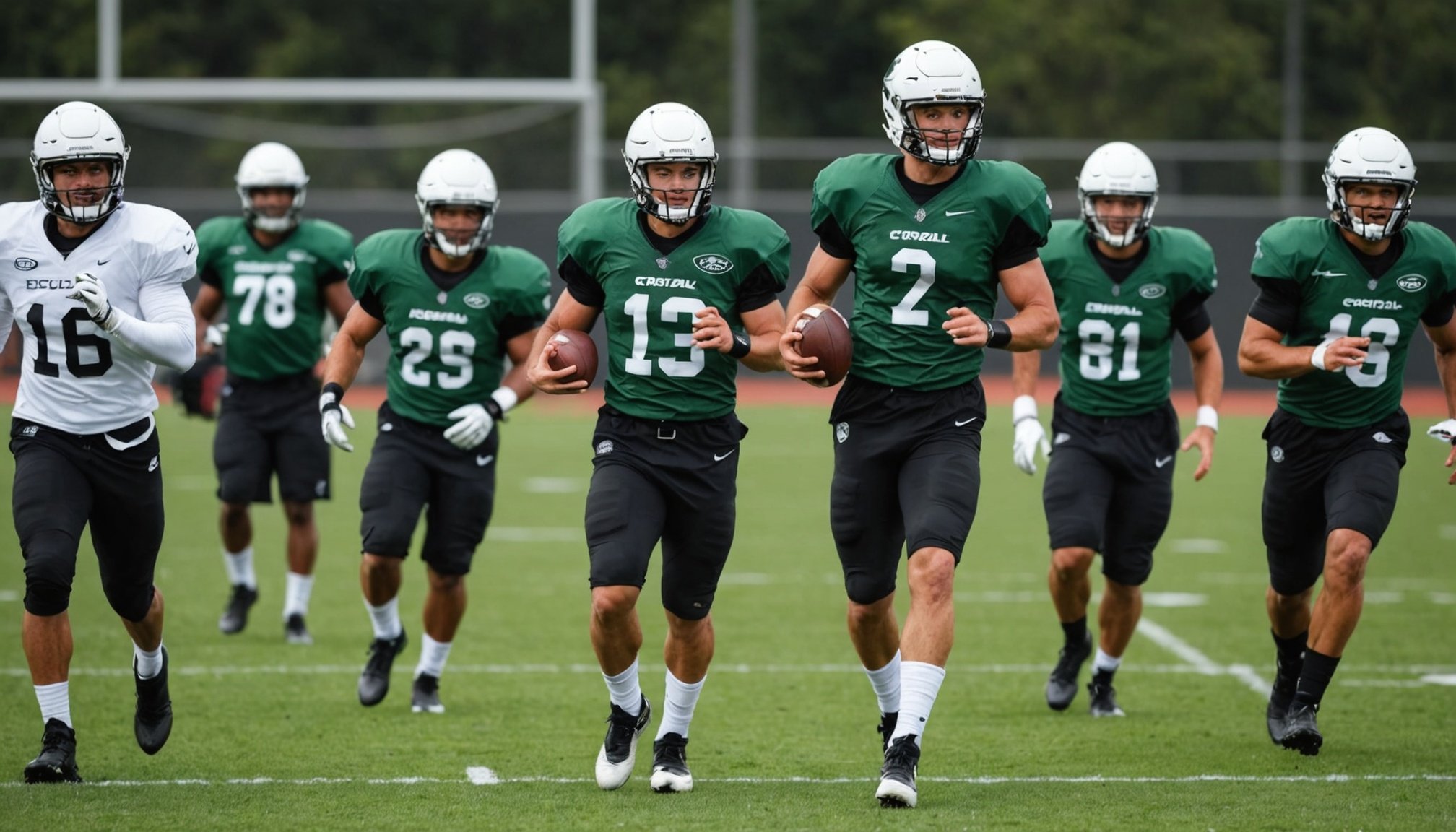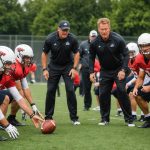Importance of Field Awareness in Football
Field awareness is crucial in football as it encompasses the ability to perceive and understand everything happening around the player. It involves not only sensing one’s position on the field but also recognising teammates, opponents, and anticipating potential movements. This awareness significantly impacts a player’s performance and helps in making quick, tactical decisions during gameplay.
Improved field awareness leads players to better assess situations, resulting in superior tactical judgments. For instance, a midfielder with enhanced awareness can swiftly identify open spaces to deliver the ball accurately to a forward, effectively creating goal-scoring opportunities. Conversely, defenders use this skill to mark opponents more efficiently and prevent attacks.
Also to discover : Revitalizing player involvement: cutting-edge techniques for football coaches to craft engaging training experiences
Real-life instances illustrate the significance of field awareness: Take Lionel Messi, renowned for his exceptional understanding of the game’s dynamics. His ability to observe and react to changing scenarios contributes to his extraordinary success on the field, underscoring the importance of awareness in shaping game outcomes.
Ultimately, fostering field awareness is integral to player development. Coaches and players alike should prioritise cultivating this skill to enhance overall team performance and maintain a competitive edge in football.
Also to read : Boosting stamina: essential techniques for football players to maximize aerobic fitness
Overview of Tactical Insight
Tactical insight is paramount in football, bridging the gap between knowledge and execution on the field. It involves understanding game tactics and applying strategic play to outsmart opponents. At its core, tactical insight enables players to anticipate moves, create opportunities, and neutralize threats. This comprehension turns raw skill into impactful performance, influencing a team’s success.
Key tactical concepts include understanding formations, pressing strategies, and transition phases. Mastery of formations allows players to exploit or cover spaces effectively. Pressing demands coordination within the team to regain possession quickly, while transitions require smooth shifting between defense and attack. Each tactic enhances a player’s strategic understanding and decision-making capabilities.
Tactical insight and field awareness complement each other, with one enhancing the effectiveness of the other. While tactical insight provides the structural understanding, field awareness ensures players perceive their surroundings accurately. Together, these skills help players predict opposition tactics, react fluidly, and maintain cohesive team play.
Thus, players who hone their tactical insight become indispensable assets, adept at navigating complex game situations and contributing to securing victories.
Training Drill 1: The Four-Quadrant Drill
The Four-Quadrant Drill is a highly effective football exercise designed to enhance multiple facets of player development.
Objective of the drill
This drill aims to improve spatial awareness and movement within confined spaces. It encourages players to recognize patterns during gameplay, fostering quicker decision-making.
Setup and execution
The field is divided into four quadrants, each representing a different task or objective. Players move between these quadrants while maintaining control of the ball and communicating with teammates. As the drill progresses, the complexity of tasks can increase, such as adding defenders or varying time constraints.
Key outcomes and improvements
Players experience substantial benefits, such as enhanced communication and decision-making under pressure. The drill also promotes engagement and teamwork, as players must effectively navigate between quadrants while adapting to live-game scenarios.
Notably, this dynamic practice encourages understanding of how to utilise space advantageously. By focusing on key tactical areas, the Four-Quadrant Drill helps players internalise spatial organisation principles, laying a foundation for effective strategic play during actual matches.
Training Drill 2: The 3v3 Possession Game
The 3v3 Possession Game is a dynamic and competitive practice designed to enhance teamwork and player synergy on the field.
Objectives and rules of the game
This drill’s primary goal is to develop quick thinking and adaptability among players. The game revolves around maintaining possession within a limited space, urging teams to pass effectively while under pressure from opponents. Players learn to read and react swiftly, a critical component of tactical insight.
Roles assigned to players
In this exercise, each player has a specific function within the team, enhancing cooperation and understanding of tactical positioning. Attackers work on building connections and strategizing passes, while defenders focus on intercepting and disrupting opponents’ gameplay. This interplay fosters a comprehensive understanding of both offensive and defensive tactics.
Analysis of success factors
Success in this drill hinges upon the players’ ability to anticipate and read the opposition’s movements, promoting an acute sense of field awareness. Effective execution improves seamless transitions, boosts confidence in ball handling, and strengthens communication skills. Overall, it enriches players’ strategic understanding and adaptability in real-match scenarios.
Training Drill 3: The Tactical Shadowing Drill
Incorporating tactical drills like the Tactical Shadowing Drill is vital for developing advanced player skills, particularly in player positioning and understanding space dynamics. This drill emphasizes shadowing techniques, allowing players to mirror opponents’ movements meticulously.
Purpose of the drill
The primary aim of this drill is to train players in anticipating opponents’ actions adeptly. By focusing on shadowing techniques, players enhance their defensive positioning. This awareness is crucial for accurately predicting where an opponent might move next, empowering players to counter attacks efficiently.
Setup and execution
During the Tactical Shadowing Drill, one player assumes the role of the attacker, while another takes on the shadowing position. The drill plays out in various formations, encouraging adaptability. Emphasis is placed on maintaining close proximity without infringing on space, teaching players how to leverage positioning as a defensive strength.
Insights gained from practice
Executing this drill consistently reinforces strategic play by fostering an acute sense of terrain management. Players gain insights into controlling space effectively and understanding movement dynamics in relation to an opponent. This intuitive knowledge significantly enhances both defensive strategies and offensive counter-play, elevating overall game performance and player development.
Implementation Tips for Coaches
Enhancing football skills requires effective coaching strategies and well-planned drill implementation. Consistent practice is integral, as it helps players internalize techniques and adapt to various game scenarios. Coaches should focus on giving regular feedback to players, highlighting strengths while addressing areas for growth. This continuous loop of practice and feedback ensures player enhancement.
Customizing Drills for Skill Levels
Adapting drills to the skill levels of different players is crucial. By adjusting the complexity of exercises, coaches can maintain a level of challenge that encourages improvement without causing frustration. This approach not only elevates individual capabilities but also fosters a more cohesive team environment.
Multimedia Resources for Effective Teaching
Utilizing multimedia resources like video tutorials and analysis tools can significantly aid in drill implementation. Visual demonstrations provide players with a clear understanding of techniques and strategies, making abstract concepts more tangible. Coaches can improve player comprehension and engagement by integrating these tools.
With thoughtful application of these tips, coaches can create a supportive learning environment, empowering players to achieve their full potential and enhancing team performance.
Monitoring and Measuring Improvement
Monitoring player assessment is vital for understanding progress in skill development. Effective performance tracking identifies areas of improvement and informs strategic adjustments in training.
Methods for Assessing Improvement
To evaluate improvement in field awareness, coaches can use video analysis, observing how well players anticipate movements and make tactical decisions during games. Recorded footage allows detailed review of gameplay, highlighting successful recognitions of positioning and space use.
Tools and Metrics
Incorporating advanced tools like GPS trackers and heart rate monitors provides quantitative data on performance metrics. These tools measure a player’s speed, positioning accuracy, and stamina, offering a data-driven approach to monitoring progress. Metrics such as successful passes and interceptions further inform improvement in strategic play.
Adjusting Training Approaches
Adjust training regimens based on performance results, focusing on areas requiring further development. Drills can be intensified or modified to target specific weaknesses, ensuring continuous skill enhancement. Regular feedback based on assessments encourages players to strive for improvements.
Using these methods effectively facilitates comprehensive player development, ensuring that skills such as field awareness are systematically enhanced. By continuously adapting strategies and resources, coaches can help players achieve a higher level of football understanding and overall performance.











